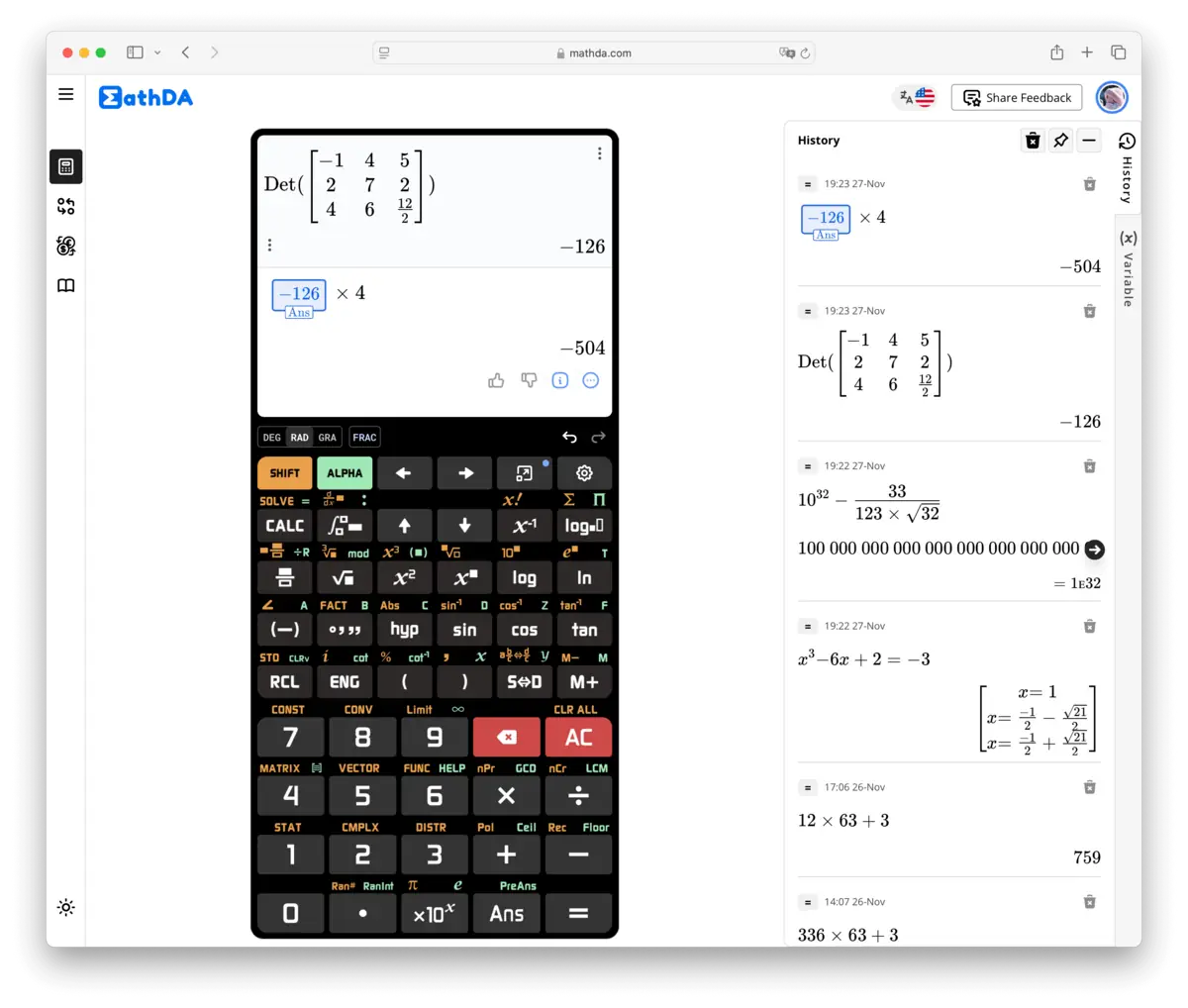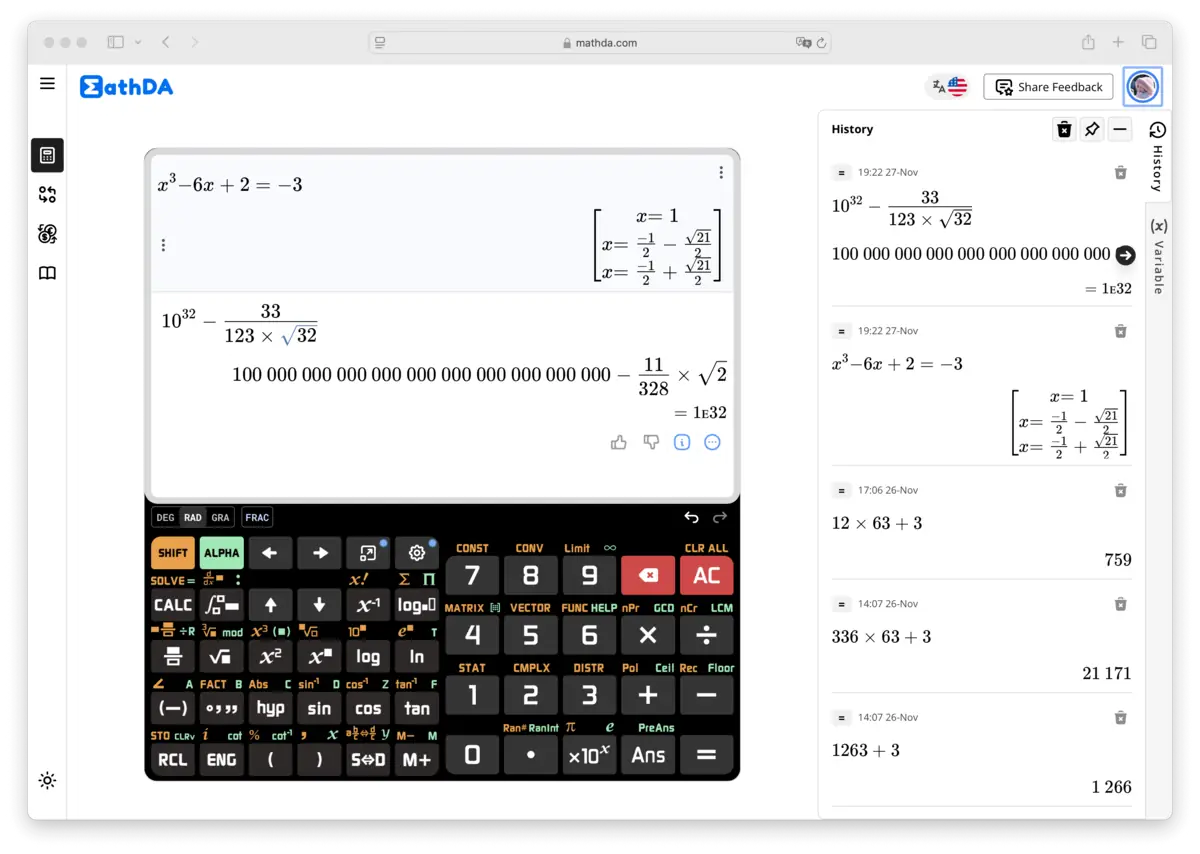The Ultimate Guide to Scientific Calculators
1. Introduction
A scientific calculator is a powerful tool designed for complex mathematical computations that go far beyond the capabilities of a standard calculator. It performs not only basic arithmetic but also advanced functions essential for higher education, engineering, science, and mathematics. Scientific calculators are invaluable in educational and professional settings, assisting students and professionals with precise calculations.

In addition to physical calculators, there’s a convenient online scientific calculator available on our website. This tool mirrors the functions of traditional scientific calculators and adds the advantage of accessibility from any internet-enabled device, ensuring calculations are always at your fingertips. The Scientific Calculator Online 991 Plus is an advanced version offering a plethora of features suited for complex mathematical operations, catering to the needs of students, educators, and professionals alike.

2. Key Features of a Scientific Calculator
Scientific calculators come packed with a variety of functions that make them superior to basic calculators. Here’s a breakdown of these key features:
- Basic Arithmetic: Performs standard operations like addition, subtraction, multiplication, and division, which are essential for everyday calculations.
- Exponential Functions: Calculations involving exponents and roots are made easy. This includes squares, square roots, and other powers.
- Trigonometric Functions: Functions such as sine, cosine, and tangent (and their inverses) are crucial for solving geometry and physics problems.
- Logarithmic and Exponential Functions: Scientific calculators handle both natural (ln) and base-10 logarithmic calculations, as well as exponential operations.
- Complex Number Calculations: For more advanced studies, these calculators can perform calculations with complex numbers, essential in engineering and physics.
- Statistical Functions: Features for calculating mean, standard deviation, and other statistical values are included, making it easier for students and professionals alike.
- Memory Functions: Values can be stored and recalled, streamlining the process of working with multiple-step problems.
The Scientific Calculator Online 991 Plus enhances these capabilities, offering additional features such as matrix calculations, integration, differentiation, and equation solving, making it a comprehensive tool for complex mathematical tasks.

3. Understanding the Scientific Calculator 991 Plus
The Scientific Calculator 991 Plus is an advanced tool used by students and professionals around the world. Key components and features include:
- User Interface: Designed to be intuitive, it allows users to easily navigate complex operations.
- Advanced Mathematical Functions: Supports additional functions like hyperbolic trigonometry, vector calculations, and statistical regression, ideal for advanced studies and professional tasks.
Its versatility and ability to handle complex operations make it a top choice for anyone dealing with intensive calculations.
4. Advantages of Using an Online Scientific Calculator
Our online scientific calculator offers several benefits over traditional calculators:
- Accessibility: Accessible anytime and anywhere via our website, it ensures users have access to essential mathematical tools wherever they are.
- Cost-effectiveness: Unlike a physical calculator, our online version is free to use, saving you the cost of purchasing a separate device.
- Device Compatibility: Whether you’re on a desktop, mobile, or tablet, our online calculator is designed to work seamlessly on all platforms.
- Regular Updates: With an online platform, new functions or updates can be added regularly, ensuring you always have access to the latest tools and bug fixes.
Additionally, the Scientific Calculator Online 991 Plus provides an intuitive user interface, making it easy for users to transition from a physical calculator to an online version without losing productivity.

5. Applications of a Scientific Calculator
Scientific calculators serve a wide range of applications:
- Education: They’re indispensable for STEM students, aiding in subjects from algebra to physics. The advanced functions of the Scientific Calculator Online 991 Plus are particularly beneficial for higher education, where complex problem-solving is required.
- Professional Use: In engineering, physics, and statistical analysis, scientific calculators allow for complex problem-solving that’s required in many technical fields. The enhanced features of the 991 Plus model further support these professional needs.
- Everyday Use: Scientific calculators can be used for household and financial calculations, such as calculating loan interest or currency conversions, making them useful even outside of academic and professional settings.
Having the flexibility to perform these tasks online ensures that users are never without their essential computational tools, saving time and effort.
6. Tips for Maximizing Use of Scientific Calculator Online 991 Plus
To get the most out of the Scientific Calculator Online 991 Plus, consider the following:
- Familiarize with the Interface: Spend time getting to know all available functions and shortcuts to improve calculation efficiency.
- Regular Practice: Use the calculator regularly to become proficient in using it for a variety of tasks.
- Utilize Online Resources: Access tutorials and guides that explain how to perform specific calculations, especially complex functions like matrix operations or integration.
7. Conclusion
Our online scientific calculator is a powerful and versatile tool that brings the capabilities of a physical scientific calculator to the convenience of your browser. Whether you’re a student, an engineer, or simply someone who needs precise calculations, we encourage you to try it out.
The Scientific Calculator Online 991 Plus offers even more advanced features that meet the rigorous demands of academic and professional environments. With the accessibility, affordability, and versatility of our online calculator, there’s no need to invest in a physical device. Explore this tool along with the other resources available on our website, and discover how our scientific calculator can support your educational and professional goals.
Frequently Asked Questions (FAQ) about Online Scientific Calculators
1. What is an online scientific calculator?
An online scientific calculator is a web-based tool that allows users to perform complex mathematical calculations such as trigonometry, logarithms, exponents, statistics, and more. It typically mimics the functionality of physical scientific calculators.
2. How do I access an online scientific calculator?
You can access an online scientific calculator through various websites or apps. Simply search for "MathDA scientific calculator" in your web browser, and choose one that fits your needs.
3. Do I need to download or install software to use it?
No, online scientific calculators work directly in your browser without requiring downloads or installations.
4. What kind of calculations can I perform?
You can perform a wide range of calculations, including:
- Basic arithmetic (addition, subtraction, multiplication, division)
- Trigonometric functions (sin, cos, tan, etc.)
- Logarithmic and exponential calculations
- Statistical functions (mean, standard deviation, regression, etc.)
- Complex numbers and matrix operations
- Unit conversions
5. Is it free to use?
Our online scientific calculator is free to use.
6. Can I graph functions using an online scientific calculator?
Yes, our online scientific calculators include graphing features. You can plot functions for better understanding.
7. Is an online scientific calculator accurate?
Yes, our online calculators are highly accurate.
8. Can I use it on my smartphone or tablet?
Yes, our online scientific calculator is usually mobile-friendly and works well on smartphones and tablets.
9. Are online scientific calculators safe?
Yes, our online scientific calculator is safe to use.
10. Can it solve equations or show step-by-step solutions?
Yes, our online calculator can solve equations.
11. Are there any limitations to using online scientific calculators?
Our online scientific calculator is powerful.
12. Can students use them during exams?
It depends on the exam rules. Some exams allow the use of online tools, while others restrict them to prevent cheating.
13. Does our online scientific calculator work like a real calculator?
Yes, our online scientific calculator functions like real scientific calculators, replicating the behavior of physical calculators.